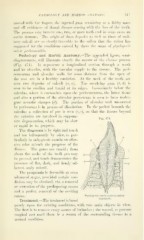Page 513 - My FlipBook
P. 513
PATHOLOGY AND MORBID ANATOMY 511
moved with the fijigers, the injected gum remaining as a flabby mass
and all evidences of dental disease ceasing with the loss of the teeth.
The process may involve one, two, or more teeth and in some cases an
entire denture. The origin of these deposits as well as those of ordi-
narv calculi are so clearly traceable to the saliva that the writer has
suggested for the conditions caused by them the name of ptyalogenic
calcic pericementitis.
Pathology and Morbid Anatomy.—The apjiended figure, semi-
diagrammatic, will illustrate clearly the nature of the disease process
(Fig. 474). It represents a longitudinal section through a tooth
and its alveolus, with the vascular supply to the tissues. The peri-
cementum and alveolar walls for some distance from the apex of
the root are in a healthy condition. At the neck of the tooth are
seen two deposits of calculi (a, a). The overlying gum (h, b) is
seen to be swollen and tumid at its edges. Immediately below the
calculus, where it encroaches upon the pericementum, the latter tissue
and also a portion of the alveolar periosteum is seen to have under-
gone necrotic changes (d). The portion of alveolar wall uncovered
by periosteum is in process of dissolution. In the pocket beneath the
calculus a collection of pus is seen (c, c), so that the tissues beyond
the calculus are involved in suppura-
Fig. 474.
tive degeneration, which may be slow
or rapid in its progress.
The diagnosis is by sight and touch
and not infrecpiently by odor, as par-
ticularly in unhygienic mouths an offen-
sive odor attends the progress of the
disease. The gums are tumid ; from
about the necks of the teeth pus may
be pressed, and touch demonstrates the
—
presence of flat, dark, and firmly ad- d
herent scaly calculi.
The prognosis is favorable at even
advanced stages, provided certain con-
ditions may be obtained, viz. a removal
or correction of the predisposing causes
and a perfect removal of the exciting
causes. Ptyalogenic calcic pericementitis
(Burchard).
Treatment.—The treatment is based
purely upon the existing conditions, with two main objects in view.
The first is to remove every source of irritation ; the second, to procure
surgical rest until there is a return of the surrounding tissues to a
normal condition.


